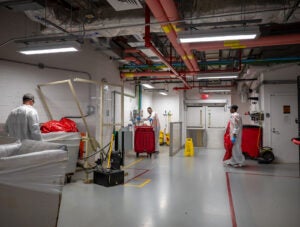
Safety and Security: How We Manage Regulated Medical Waste
Not all waste is created equal, especially in a hospital setting. The waste we discard can’t be tossed haphazardly. It takes diligence and strict compliance to ensure that all potentially dangerous materials are disposed of safely and responsibly.
At UVA Health, we have a team that sets the standard for the management of regulated medical waste (RMW). Led by Safety Officer Jessica Pardue, the Environmental Services (EVS) team collects, transports, and disposes of around 92 tons of RMW monthly.
“We are the biggest on-site treater of regulated medical waste in the state of Virginia,” says Tony Caswell, Regional Director of Operations.
(Photo above: UVA Health's medical waste team members Muheto Bahati, William Bimenyimana, Ahmad Alboni, Basel Bouz Alassal, and Mohammad Boz Al Asaal.)
What is RMW?
UVA policy defines RMW as: “any waste materials capable of producing a disease by an organism likely to be pathogenic to healthy humans.” This includes Category A waste or waste contaminated with potentially life-threatening, highly contagious pathogens like Ebola or Monkey Pox.
How do we dispose of RMW?
There’s a multi-step process to dispose of RMW, which is highly regulated by the Virginia Department of Environmental Quality (DEQ). Once a quarter, the DEQ stops by unannounced to evaluate our compliance. UVA Health has maintained an unblemished record for over 48 consecutive quarters, an achievement attributed to the EVS team’s diligence and adherence to best practices.
“We've had the state decide to hold their annual training here this year. They had a consultant who travels all over the world, and he was absolutely amazed at the way our facility runs,” says Caswell.
The journey for RMW, from the hospital to the landfill, includes the following steps:
Collection
All RMW is to be placed in red bags marked “biohazard.” Staff working in an area that generates RMW should be trained on what materials belong in these red bags. In general, this includes:
- Materials contaminated by blood and bodily fluids
- Potentially infectious waste
- Blood products
- Cultures, stocks
- Soiled personal protective equipment (PPE)
In hectic moments, Caswell acknowledges that things can wind up in the wrong receptacle. And it’s against regulation to remove items once they’re discarded into red bags. But sharps can be a real hazard for the EVS team, so “please throw needles in the sharps box,” he says.
When red bags are two-thirds full, a member of the EVS team will seal them and place them in a red barrel for transport. If the bag contains Category A waste, EVS sends a team to clean the area, and the waste is fast-tracked to the autoclave.

Transport
Red barrels are taken to one of the hospital’s 45 soiled utility rooms, where the contents are loaded into 96-gallon containers aka “toters.” When those are full, we have a dedicated team of transporters who collect them and move them to the South Dock.
“Transporters have to make sure that the lid is completely sealed and closed and locked before they take it from the soiled utility room through the hospital down to the South Dock,” says Pardue.
How often these toters are moved depends on the location. “In an ICU, these toters may come down twice in an eight-hour shift. For a regular unit, it may be 24 hours before they’re full,” says Caswell.
Once toters arrive at the dock, they are placed in color-coded zones that signify which toters are ready to be emptied and which are clean and ready to be returned to the soiled utility rooms. "Jess and her team are leaders in the nation for the process they’ve adopted on the dock. They have really embraced Lean Six Sigma to improve efficiency,” says Caswell.
Sterilization
The dock team, outfitted in PPE, empties the toters into smaller bins designated for the autoclave or steam sterilizer. The autoclave holds four bins, which are loaded in and secured behind a steel door. Then, it’s time to “cook.”
The sterilizer is heated to 285 degrees, and it cooks the RMW for five minutes. The machine then pulls all air out of the chamber. Another 25-minute round of cooking follows. If the bins hold Category A waste, this whole process is done twice.
Each cycle is logged on a chart, which is reviewed every 90 days by the DEQ. “They look to make sure every load is cooked at the right temperature for the right duration,” says Caswell.
They also check to be sure the autoclave is functioning properly. “We've developed a maintenance schedule for the autoclave. We have a lot of preventive measures in place, so we're not stuck with piling-up medical waste,” says Pardue.
Part of that maintenance is performing a spore check monthly. This is to make sure “everything in the vessel is getting killed,” says Caswell.
The autoclave runs approximately seven hours a day, seven days a week. But sometimes the need is greater, and the EVS team is at the ready. “During COVID, the vessel ran 20 hours a day, seven days a week,” says Caswell.
Disposal
Once RMW has been sterilized, it’s put into a compactor that is collected by an outside vendor and taken to a designated landfill for medical waste. There, the waste is dumped into a hole or cell carefully constructed and sealed, preventing environmental contamination.
While this entire process happens behind the scenes, it’s critical to our operations. The EVS team’s innovative processes and commitment to excellence demonstrates that even "trash" management can reflect world-class care.
Interested in being part of the Safety and Security Subcommittee? Email Rebecca Hill for details.
Latest News









Having been in healthcare for over 22 years, I’ve never known what happens to waste after it leaves my area. This was such an eye-opening read. I really enjoyed this information, thank you for sharing!